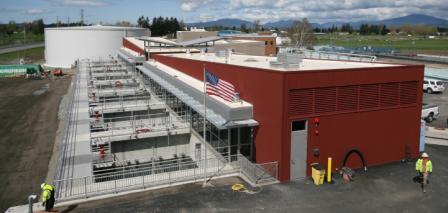Anacortes, Washington Rebuilds Water Treatment Plant for Climate Change
 The New Anacortes Water Treatment Plant.The city of Anacortes, WA recognized that its water treatment plant, located along the Skagit River and serving 56,000 people, was vulnerable to current floods and future climate risks. In 2003, the city recognized the need to update the facility from 21.4 million gallons of water per day (mgd) to a stated capacity of 31.5 mgd. Moving the facility out of the floodplain was deemed cost prohibitive in 2008, so officials decided to rebuild on the existing site. Such a strategy can be risky unless climate projections are taken into account and adaptation strategies implemented to reduce future vulnerability.
The New Anacortes Water Treatment Plant.The city of Anacortes, WA recognized that its water treatment plant, located along the Skagit River and serving 56,000 people, was vulnerable to current floods and future climate risks. In 2003, the city recognized the need to update the facility from 21.4 million gallons of water per day (mgd) to a stated capacity of 31.5 mgd. Moving the facility out of the floodplain was deemed cost prohibitive in 2008, so officials decided to rebuild on the existing site. Such a strategy can be risky unless climate projections are taken into account and adaptation strategies implemented to reduce future vulnerability.
To determine the plant’s vulnerability, Anacortes officials worked with non-profit organizations to determine the ‘best available’ climate science and the associated impacts to the plant siting. A variety of climate risks were taken into account including:
- more frequent and intense storms
- saltwater intrusion
- increased sedimentation levels
Climate change impacts were projected through the 2080s and downscaled for the Skagit River area. These vulnerabilities included an expanded 100-year floodplain, an estimated 350% increase in peak suspended sediment load in winter, and anticipated upstream migration of the salt water wedge due to the effects of sea level rise.
In design and construction of this plant, officials sought to protect against higher risk of flooding by:
- minimizing penetration below current 100 year flood elevation
- raising critical electrical equipment out of the 100 year flood level
- utilizing water proofing techniques below 40 foot elevation
- designing ring dikes for flood protection
This plant was rebuilt on site at an expected cost of $56 million dollars and improvements to this design better prepare the facility to meet increased service demand as well as projected changes in climate.
How Did They Do It? |
Applicable EPA Tools |
|---|---|
|
Recognized climate risk and expected vulnerability
|
The EPA Coastal Inundation Toolkit can assist utilities in better understanding facility vulnerability by illustrating a range of potential sea level rise and storm surge scenarios. |
|
Incorporated projections of climate vulnerability within plant design to adapt to future conditions
|
EPA’s Creating Resilient Water Utilities Adaptation Strategies Guide can assist utilities in identifying low cost adaptation strategies to incorporate within plan designs. EPA’s Creating Resilient Water Utilities Adaptation Strategies Guide |
|
Identified information gaps for future research
|
The Climate Resilience Evaluation and Awareness Tool (CREAT) helps utilities conduct traditional risk based or scenario based vulnerability assessments to better understand information gaps and necessary future research. The Climate Resilience Evaluation and Awareness Tool (CREAT) |
Similar Cases and More Information
To see how a community analyzed the impact of sea level rise on a water utility, view Manchester-by-the-Sea. For a community that recognized the prohibitive cost of protecting a highly vulnerable facility and decided to move to a safer facility, see Iowa City. Protecting the Blue Plains facility is only one of several strategies Washington, D.C. has taken to reduce the threat of flooding on the community. To see how Washington, D.C. is using green infrastructure to reduce stormwater impacts and combined sewer overflows view the DC Consent Decree.
- Manchester-by-the-Sea, Massachusetts Assesses Climate Vulnerability
- Iowa City, Iowa Closes Vulnerable Wastewater Facility
- DC Utilizes Green Infrastructure to Manage Stormwater
References
The following links exit the site Exit
- Skagit Climate Science Consortium (SC2) Drinking Water (PDF) (2 pp, 867 K, About PDF)
- City Of Anacortes Water Treatment Plant: Climate Change Impact Mitigation (PDF) (29 pp, 5.4 MB)
- The Co-Production of Actionable Science for Assessment and Adaptation: Six Case Studies from the Water and Clean Water Communities (PDF)(36 pp, 915 K, About PDF)
- Salish Sea Ecosystem Conference: City of Anacortes Water Treatment Plant Climate Change Mitigation (PDF) (24 pp, 5.5 MB)
- 2008 Skagit County National Hazards Mitigation Plan (PDF) (19 pp, 136 K)

